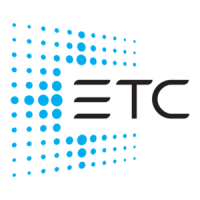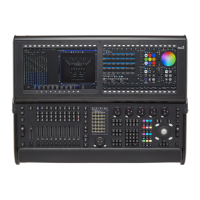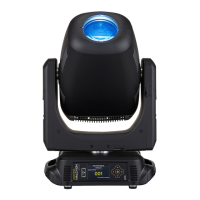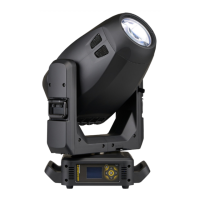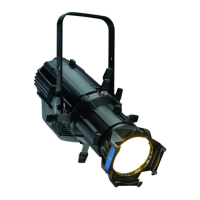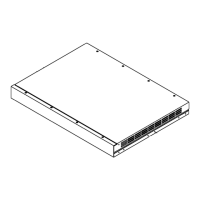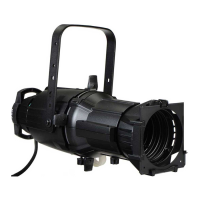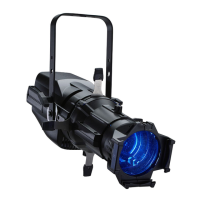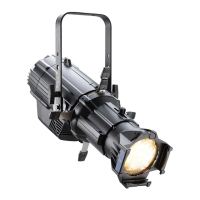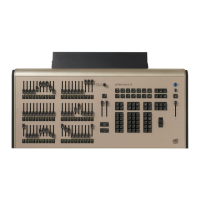Do you have a question about the ETC HedgeHog 4 and is the answer not in the manual?
Details the primary user input method for Hog 4 OS, covering command line syntax and structure.
Explains the GUI features, window management, and interaction methods like touch screen and trackball.
Explains the default tracking behavior of Hog 4 OS, where only changed cue data is recorded.
Details the Highest Takes Precedence (HTP) and Latest Takes Precedence (LTP) concepts for parameter control.
Explains how palettes simplify programming by storing preset lighting elements and how they are organized in directories.
Provides guidance on console setup, location considerations, and powering on the system.
Details the fundamental settings for the DMX Processor 8000, including net and port number configuration.
Explains the HogNet network, its components, and connection requirements for consoles and processors.
Guides users through the process of creating and launching a new show file.
Recommends and details the process for regularly backing up show files.
Guides users on how to add fixtures to a show and schedule them.
Details how to patch fixtures, assigning DMX addresses and protocols.
Details three methods for selecting fixtures: command line, visual selection, and groups.
Explains various ways to adjust fixture parameters using command line, trackball, wheels, and spreadsheets.
Details the process of recording groups, focusing on active fixture selections.
Guides on recording preset values (intensity, position, color, beam, effects) into palettes.
Explains how to apply palettes by selecting them from directory windows.
Guides on recording a look as a cue within a cuelist or to a master.
Details how to assign fade time, delay time, and path values to cues and scenes.
Describes how to apply predefined effects palettes to the current fixture selection.
Explains how kinds organize fixture functions and how fixed and user kinds are structured.
Describes the ten physical playback masters and how to configure them.
Explains running cuelists without physical masters using virtual masters.
Explains the LTP rule where the most recent instruction determines parameter value.
Describes switching precedence from LTP to HTP for intensity parameters.
Explains the Grand Master's function to inhibit fixture intensities and DBO key functionality.
Explains MIDI Show Control (MSC) support for basic playback control messages.
Guides on bringing OSC messages into the console by configuring network ports.
Details how to send OSC messages from the console by configuring output ports and protocols.
Explains how to input LTC signals directly into Hog 4-18, Hog 4, Full Boar 4 consoles.
Details how to bring LTC into the system using a DMX Processor 8000.
Guides on setting DMX channel or group values manually.
Explains how to build, save, delete, and run custom queries for searching show data.
Provides instructions for downloading and installing fixture libraries onto the console.
Details how to create, build, and export custom fixture types using the Fixture Builder utility.
Details the installation process for the Hog 4 Connectivity application.
Explains how to physically connect the console to the visualizer PC using an Ethernet cable.
Guides on configuring network settings on the visualizer PC for connectivity.
Details enabling the visualizer stream and configuring the console for visualizer connectivity.
Describes the two methods for updating Hog console software: FPSPkg and drive image.
Explains the process of performing a full software installation, which erases all data.
Explains the necessity of updating DMX processor software along with console software.
Describes the procedure for installing a full copy of DMX Processor software.
Provides system requirements and instructions for installing Hog 4 PC.
Addresses issues where the console fails to start properly or goes directly to shutdown.
Troubleshooting steps for lack of DMX output from console's built-in outputs.
Steps to resolve issues with no Art-Net output from the console's FixtureNet port.
Provides guidance on restarting individual processes to resolve console crashes or freezes.
Troubleshooting steps for communication failures between the console and DMX Processor 8000.
Checks if playback controls have been mapped to different functions than normal.
Troubleshoots issues with the ETCnomad Key not being recognized by Hog 4 PC.
Addresses potential causes of front panel reboots, like radio interference.
Provides step-by-step instructions for replacing damaged screens on the console.
Details the process for replacing faders on various Hog 4 series consoles and wings.
Provides instructions for replacing the trackball assembly on Hog 4 consoles.
Provides essential instructions for continued protection against fire, electric shock, and injury.
Important safety information in French regarding fire and electric shock protection.
Important safety information in German regarding fire and electric shock protection.
Important safety information in Spanish regarding fire and electric shock protection.
Important safety information in Italian regarding fire and electric shock protection.
Important safety information in Danish regarding electric shock protection.
Important safety information in Japanese regarding fire and electric shock protection.
Contains critical instructions for continued protection against fire, electric shock, and injury.
Details the primary user input method for Hog 4 OS, covering command line syntax and structure.
Explains the GUI features, window management, and interaction methods like touch screen and trackball.
Explains the default tracking behavior of Hog 4 OS, where only changed cue data is recorded.
Details the Highest Takes Precedence (HTP) and Latest Takes Precedence (LTP) concepts for parameter control.
Explains how palettes simplify programming by storing preset lighting elements and how they are organized in directories.
Provides guidance on console setup, location considerations, and powering on the system.
Details the fundamental settings for the DMX Processor 8000, including net and port number configuration.
Explains the HogNet network, its components, and connection requirements for consoles and processors.
Guides users through the process of creating and launching a new show file.
Recommends and details the process for regularly backing up show files.
Guides users on how to add fixtures to a show and schedule them.
Details how to patch fixtures, assigning DMX addresses and protocols.
Details three methods for selecting fixtures: command line, visual selection, and groups.
Explains various ways to adjust fixture parameters using command line, trackball, wheels, and spreadsheets.
Details the process of recording groups, focusing on active fixture selections.
Guides on recording preset values (intensity, position, color, beam, effects) into palettes.
Explains how to apply palettes by selecting them from directory windows.
Guides on recording a look as a cue within a cuelist or to a master.
Details how to assign fade time, delay time, and path values to cues and scenes.
Describes how to apply predefined effects palettes to the current fixture selection.
Explains how kinds organize fixture functions and how fixed and user kinds are structured.
Describes the ten physical playback masters and how to configure them.
Explains running cuelists without physical masters using virtual masters.
Explains the LTP rule where the most recent instruction determines parameter value.
Describes switching precedence from LTP to HTP for intensity parameters.
Explains the Grand Master's function to inhibit fixture intensities and DBO key functionality.
Explains MIDI Show Control (MSC) support for basic playback control messages.
Guides on bringing OSC messages into the console by configuring network ports.
Details how to send OSC messages from the console by configuring output ports and protocols.
Explains how to input LTC signals directly into Hog 4-18, Hog 4, Full Boar 4 consoles.
Details how to bring LTC into the system using a DMX Processor 8000.
Guides on setting DMX channel or group values manually.
Explains how to build, save, delete, and run custom queries for searching show data.
Provides instructions for downloading and installing fixture libraries onto the console.
Details how to create, build, and export custom fixture types using the Fixture Builder utility.
Details the installation process for the Hog 4 Connectivity application.
Explains how to physically connect the console to the visualizer PC using an Ethernet cable.
Guides on configuring network settings on the visualizer PC for connectivity.
Details enabling the visualizer stream and configuring the console for visualizer connectivity.
Describes the two methods for updating Hog console software: FPSPkg and drive image.
Explains the process of performing a full software installation, which erases all data.
Explains the necessity of updating DMX processor software along with console software.
Describes the procedure for installing a full copy of DMX Processor software.
Provides system requirements and instructions for installing Hog 4 PC.
Addresses issues where the console fails to start properly or goes directly to shutdown.
Troubleshooting steps for lack of DMX output from console's built-in outputs.
Steps to resolve issues with no Art-Net output from the console's FixtureNet port.
Provides guidance on restarting individual processes to resolve console crashes or freezes.
Troubleshooting steps for communication failures between the console and DMX Processor 8000.
Checks if playback controls have been mapped to different functions than normal.
Troubleshoots issues with the ETCnomad Key not being recognized by Hog 4 PC.
Addresses potential causes of front panel reboots, like radio interference.
Provides step-by-step instructions for replacing damaged screens on the console.
Details the process for replacing faders on various Hog 4 series consoles and wings.
Provides instructions for replacing the trackball assembly on Hog 4 consoles.
Provides essential instructions for continued protection against fire, electric shock, and injury.
Important safety information in French regarding fire and electric shock protection.
Important safety information in German regarding fire and electric shock protection.
Important safety information in Spanish regarding fire and electric shock protection.
Important safety information in Italian regarding fire and electric shock protection.
Important safety information in Danish regarding electric shock protection.
Important safety information in Japanese regarding fire and electric shock protection.
Contains critical instructions for continued protection against fire, electric shock, and injury.
| Manufacturer | ETC |
|---|---|
| Model | HedgeHog 4 |
| Master Playbacks | 10 |
| Internal Hard Drive | SSD |
| Audio Input | Yes |
| MIDI Input/Output | Yes |
| SMPTE Timecode | Yes |
| Type | Lighting Console |
| Output | DMX512 |
| Local DMX/RDM Ports | 4 |
| Network Ports | 2 |
| External Monitor Support | Yes |
| Networking Protocols | Art-Net, sACN |
| Power Requirements | 100-240V AC, 50/60Hz |
| Connectivity | Ethernet, USB, MIDI |
